
The Indo-Pacific is a vast biogeographic region of Earth.

Panulirus versicolor is a species of spiny lobster that lives in tropical reefs in the Indo-Pacific. Other names include painted lobster, common rock lobster, bamboo lobster, blue lobster, and blue spiny lobster. P. versicolor is one of the three most common varieties of spiny lobster in Sri Lanka, alongside Panulirus homarus and Panulirus ornatus.
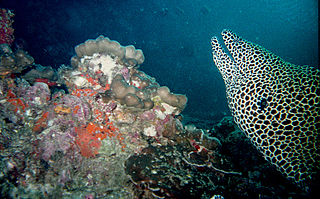
The Western Indo-Pacific is a biogeographic region of the Earth's seas, comprising the tropical waters of the eastern and central Indian Ocean. It is part of the larger Indo-Pacific, which includes the tropical Indian Ocean, the western and central Pacific Ocean, and the seas connecting the two in the general area of Indonesia. The Western Indo-Pacific may be classified as a marine realm, one of the great biogeographic divisions of the world's ocean basins, or as a subrealm of the Indo-Pacific.
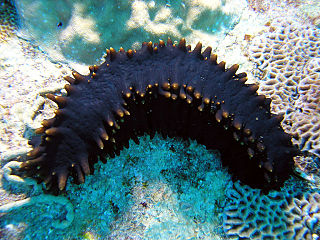
Stichopus chloronotus is a species of sea cucumber. Common names include the greenfish sea cucumber, the spiky sea cucumber and the black knobby sea cucumber. It is native to the Indo-Pacific region. It has a wide range and is abundant and the IUCN lists it as being of "Least Concern".

Pearsonothuria is a genus of sea cucumbers in the family Holothuriidae. Pearsonothuria graeffei is the only species in the genus. Graeffe's sea cucumber is found in the tropical Indo-Pacific Ocean and the type locality is Viti Island, Fiji. It is named after Eduard Heinrich Graeffe, Semper's coworker at the Museum Godeffroy.

Favites pentagona is a species of stony coral in the family Merulinidae, sometimes known as larger star coral. It is native to the Indo-Pacific region and its range extends from the Red Sea through the Indian Ocean to the Western Pacific Ocean. This is a common species throughout its wide range and the International Union for Conservation of Nature has rated its conservation status as being of "least concern".
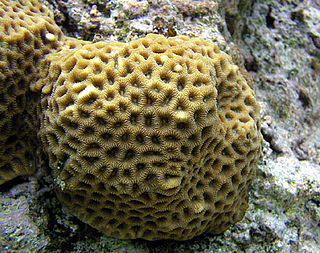
Favites abdita, also known as the larger star coral, is a species of stony coral in the family Merulinidae. It is native to the Indo-Pacific region and its range extends from East Africa and the Red Sea through the Indian Ocean to the Western Pacific Ocean. The International Union for Conservation of Nature has rated its conservation status as being "near-threatened".

Panulirus penicillatus is a species of spiny lobster that lives on shallow rocky and coral reefs in the tropical Indo-Pacific region. Common names for this spiny lobster include variegated crayfish, tufted spiny lobster, spiny lobster, Socorro spiny lobster, red lobster, pronghorn spiny lobster, golden rock lobster, double spined rock lobster and coral cray. It has a very wide range and the International Union for Conservation of Nature has assessed its conservation status as being of "least concern".

Actinopyga echinites, commonly known as the brownfish or deep water redfish, is a species of sea cucumber in the family Holothuriidae. It is native to the tropical Indo-Pacific region and is harvested for food.

Holothuria fuscocinerea, the ashy pink sea cucumber, is a species of sea cucumber in the family Holothuriidae. It is placed in the subgenus Stauropora, making its full name Holothuria (Stauropora) fuscocinerea. It is native to shallow water in the tropical and sub-tropical Indo-Pacific.

Holothuria fuscopunctata, the elephant trunkfish, is a species of sea cucumber in the family Holothuriidae native to shallow water in the tropical Indo-Pacific. It is placed in the subgenus Microthele, making its full name Holothuria (Microthele) fuscopunctata.

Dipsastraea pallida is a species of colonial stony coral in the family Merulinidae. It is found in tropical waters of the Indian and Pacific Oceans. This is a common species of coral with a widespread distribution, and the main threat it faces is from the destruction of its coral reef habitats. It is rated as a "least-concern species" by the International Union for Conservation of Nature. This species was first described in 1846 as Favia pallida by the American zoologist James Dwight Dana; it was later transferred to the genus Dipsastraea, but some authorities continue to use the original name.

Stichopus herrmanni, or Herrmann's sea cucumber, is a species of holothuroidean echinoderm in the family Stichopodidae. It is found in the tropical, western Indo-Pacific Ocean, at depths down to 20 m (66 ft). This and several other species are known as curryfish and are harvested commercially; it is called gama in Indonesia.
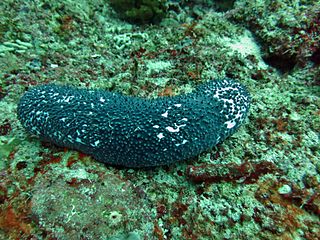
Actinopyga caerulea, the blue sea cucumber, is a species of sea cucumber in the family Holothuriidae. Named for its unique blue coloration, this species can be found along the continental shelf of the tropical Western Indo-Pacific region, at depths between 12 and 45 m. It is a commercially important species, and is harvested for food along its range.

Actinopyga mauritiana, commonly known as the surf redfish, is a species of sea cucumber in the family Holothuriidae. It is native to the tropical West Indo-Pacific region and is harvested for food.

Actinopyga miliaris, commonly known as the hairy blackfish, is a species of sea cucumber in the family Holothuriidae. It is native to the tropical West Indo-Pacific region and is harvested for food.

Actinopyga lecanora, commonly known as the white-bottomed sea cucumber or stonefish, is a species of sea cucumber in the family Holothuriidae. It is native to the tropical Western Indo-Pacific region and is harvested for food.
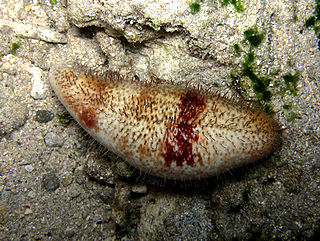
Actinopyga capillata, the hairy sea cucumber, is a species of sea cucumber in the family Holothuriidae. It is found in the tropical West Indo-Pacific region, having a disjunct range, with the main population in island groups in the western Indian Ocean, and a separate population in the Philippines.
The Dr. K.K. Mohammed Koya Sea Cucumber Conservation Reserve is a marine protected area located off the coast of the Indian union territory of Lakshadweep, approximately 50 km (31 mi) northwest of the island of Bitra. Formally established by Indian authorities on February 27th, 2020, the reserve covers 239 km2 (92 sq mi) of the Arabian Sea, including parts of the Byramgore (Cheriyapani) Reef, and is the world's first conservation area specifically dedicated to the protection of sea cucumbers.



















